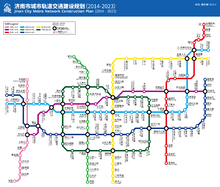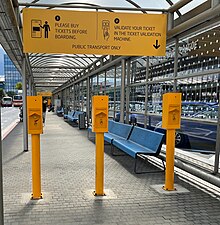Public transport software
This article is written like a personal reflection, personal essay, or argumentative essay that states a Wikipedia editor's personal feelings or presents an original argument about a topic. (March 2024) |

Public transport software encompasses a range of applications and platforms used by public transport agencies and operators to manage and optimize operations, within its transit networks. This can include route planning, ticketing, real-time tracking, asset management, customer feedback, etc.
History[edit]
The need for public transport software emerged with the rise in public transit use and the increasing complexity of transit networks in the late 20th century. Initially, manual methods were used for route planning and ticketing. As computing technology evolved, software solutions became crucial to handle the increasing demand and provide more sophisticated services to passengers.[1][2]
Types of public transport software[edit]
Route planning and optimization[edit]

This type of software aids in mapping out routes, schedules, and timings, ensuring minimal overlap, maximum coverage, and efficient use of resources. It helps transit agencies to improve punctuality and reduce operating costs.[3]
Ticketing and payment systems[edit]

Modern ticketing systems have moved beyond traditional paper tickets. With the advent of smartcards, mobile apps, and contactless payments, software platforms now handle complex fare calculations, payment processing, and revenue management.[4][5]
Real-time tracking and monitoring[edit]
With the help of GPS and other tracking technologies, these platforms provide real-time updates on vehicle locations, delays, and expected arrival times.[6] They also offer vital data to transport agencies and can be accessed by passengers through various means, including mobile apps and electronic display boards.[citation needed]
Maintenance and asset management[edit]
These platforms are used for monitoring the condition of vehicles and infrastructure, scheduling regular maintenance, and ensuring the longevity and safety of transit assets.[7]
Customer service and engagement[edit]
Modern public transport relies on customer feedback and engagement for improvements.[8] Software solutions can gather and analyze feedback, manage complaints, and provide passengers with timely updates and notifications.
See also[edit]
References[edit]
- ^ Katona, Geza; Juhasz, Janos (2020-01-02). "The History of the Transport System Development and Future with Sharing and Autonomous Systems". Communications - Scientific Letters of the University of Zilina. 22 (1): 25–34. doi:10.26552/com.C.2020.1.25-34. S2CID 213288680.
- ^ Gajewska, Teresa; Walczyk, Dominika (2023-08-07). "Development of Transport Management Software". Sustainability. 15 (15): 12083. doi:10.3390/su151512083. ISSN 2071-1050.
- ^ Foth, Marcus; Schroeter, Ronald (2010-10-06). "Enhancing the experience of public transport users with urban screens and mobile applications" (PDF). Proceedings of the 14th International Academic MindTrek Conference: Envisioning Future Media Environments. MindTrek '10. New York, NY, USA: Association for Computing Machinery. pp. 33–40. doi:10.1145/1930488.1930496. ISBN 978-1-4503-0011-7. S2CID 12218853.
- ^ European Commission. Joint Research Centre. (2022). Public transport research and innovation in Europe: an assessment based on the Transport Research and Innovation Monitoring and Information System (TRIMIS). LU: Publications Office. doi:10.2760/18036. ISBN 9789276530671.
- ^ Rawdah, Rawdah; Ali, Syed Shafin (2021-01-05). "Proposing a Real-Time Ticket Monitoring System for Public Transport in NSW, Australia". 2021 2nd International Conference on Robotics, Electrical and Signal Processing Techniques (ICREST). IEEE. pp. 221–224. doi:10.1109/ICREST51555.2021.9331127. ISBN 978-1-6654-1574-3. S2CID 231823758.
- ^ Ao, S. I.; International Association of Engineers, eds. (2012). International Conference on Computational Biology 2012, International Conference on Chemical Engineering 2012, International Conference on Circuits and Systems 2012, International Conference on Communications Systems and Technologies 2012, International Conference on Electrical Engineering and Applications 2012, International Conference on in Modeling Health Advances 2012, International Conference on Modeling, Simulation and Control 2012, International Conference on Systems Engineering and Engineering Management 2012 (PDF). World Congress on Engineering and Computer Science, WCECS 2012, San Francisco, USA, 24 - 26 October, 2012 / Eds.: S. I. Ao. Hong Kong: IAENG, International Association of Engineers. ISBN 978-988-19252-4-4.
- ^ April, Alain; Abran, Alain (2008). Software maintenance management: evaluation and continuous improvement. Hoboken, NJ: Wiley. ISBN 978-0-470-14707-8.
- ^ Kampf, Rudolf; Ližbetinová, Lenka; Tišlerová, Kamila (2017-03-20). "Management of Customer Service in Terms of Logistics Information Systems". Open Engineering. 7 (1): 26–30. Bibcode:2017OEng....7....6K. doi:10.1515/eng-2017-0006. ISSN 2391-5439. S2CID 113472550.
